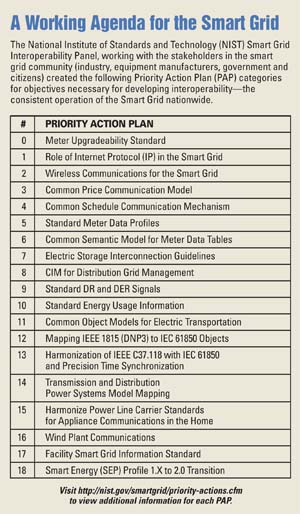Step-by-Step, Marching to the Smart Grid
 |
All-electric cars and trucks can recharge off the grid overnight without overwhelming power plants and distribution systems. |
It is a project that most officials and power industry leaders acknowledge will take 20 to 30 years. But already, government and industry representatives involved in upgrading the United States’ electrical infrastructure to the highly anticipated smart grid are reporting success in developing some of the first standards for the long-term nationwide project.
The standards have been developed by the public-private Smart Grid Interoperability Panel (SGIP), which is coordinated by the National Institute of Standards and Technology (NIST) in Gaithersburg, Maryland.
The smart grid is an effort to knit together the existing electrical transmission system, some of which is more than 75 years old, with new and emerging technologies, such as the wireless Internet and networked home appliances.
SGIP has divided its work into a series of 18 Priority Action Plans (PAPs), each of which is linked to key standards organizations and industry user associations with an intrinsic interest in a specific standard. The PAPs carry straightforward labels, such as “Role of IP (Internet protocol) in the Smart Grid,” to more esoteric, industry-specific titles, such as “Mapping IEEE 1815 (DNP3) to IEC 61850 Objects.”
Paul Molitor is assistant vice president and industry director for smart grid at the National Electrical Manufacturers Association (NEMA) in Arlington, Virginia, and a key member of the SGIP. He says that NIST and the SGIP originally identified as many as 75 different needs for standards for the smart grid, but it narrowed those down to the 18 PAPs and, he emphasizes, “That’s where we began to focus on writing these standards.”
PAP0, the first of the PAPs to be completed, deals with a standard for the upgradeability of the ubiquitous electric meter found in homes and businesses. Molitor relates that state utility commissions had concerns about the costs of ongoing plans to replace existing analog mechanical electric meters with so-called smart meters, which are designed to do a better job of measuring electricity use.
State utility commissions were weighing the expense of installing smart meters against the concern that all of the NIST standards for smart grids had not been identified yet, he explains. Officials at the commissions worried that smart meters might have to be replaced before their service life ended if the underlying standards changed.
Molitor says NIST convened a working group, including NEMA, taking advantage of the work that the association already had done regarding the smart meter upgradeability standards. “This team of utilities and manufacturers, some government types and a few independent contractors,” Molitor explains, “came together and wrote the meter upgradeability standard to help those state utility commissions make decisions” in the deployment of smart meters, which are now in approximately five percent of homes and commercial buildings across the country.
The smart meter specifications contained in PAP0 are nearly two years old, and Molitor says the SGIP already is considering modifications to reflect changing needs and priorities.
“In the past, these were very much what industry needed. But now that we are talking about putting more control in the hands of consumers, to provide them with more usage information directly from their meter,” he continues, “the purpose and underlying technologies for meters are changing, so that they are more for industry and consumers.”
Molitor adds that the PAP0 is written in such a way that it enables operators to “future-proof” these meters to accommodate technology and software applications that are still on the drawing board.
Earlier this year, the SGIP’s Cyber Security Working Group issued a second draft of cybersecurity recommendations that the North American Electric Reliability Corporation may consider implementing in the future. Those recommendations would answer questions now being asked about protecting networked smart meters from hackers.
 |
Unlike PAP0, PAP2 currently reflects only wireless technologies now in widespread use. Molitor says, for example, that PAP2 does not yet address the emerging technology of WiMax or metropolitan-area-wide wireless network connectivity that uses the same underlying technology of Wi-Fi—which is used for short-distance connections within homes, offices and businesses.
Molitor emphasizes that the work of developing the smart grid is just beginning, and he says there is a lot of work still to be done, particularly in terms of developing the most basic technical standards for a fully mature smart grid.
“If you look at other industries, there are thousands of Internet standards—a couple of hundred for the digital phone network—and so if we’ve just gotten through the process of identifying the first 90, between the Priority Action Plans and the standards that were identified,” he continues, “then we might be a quarter of the way done in terms of identifying everything that we need done” to achieve a fully operational smart grid.
As far as that goal is concerned, George Arnold, national coordinator for smart grid interoperability with NIST, emphasizes that in some cases, as in the smart meters, tangible results of the development will provide industry and consumers with benefits almost as soon as they are developed. In other cases, however, it may take time for those aspects of the smart grid to bear fruit.
“They may notice fewer outages,” Arnold says, adding, “For example, there are phaser-measurement units that are used to monitor the health of the transmission network.” The 2009 American Recovery and Reinvestment Act—better known as the Stimulus Bill—provided action funding to deploy nearly a thousand of these units in the high-voltage transmission grid, he says.
Just as the smart meters will give homeowners and commercial building operators the tools to manage their electrical consumption more efficiently, Arnold explains, “What these units do is provide a measure of real-time situational awareness of the health of the grid. It’s like putting an EKG [electrocardiogram] on the grid. This allows grid operators to discern much more quickly when failures in the grid have the potential to lead to more significant outages.”
He believes that had phaser-management units been deployed at the time of the August 13, 2003, blackout that affected much of the northeastern and Midwest United States and Canada, “It’s very likely that this blackout could have been averted.” That outage affected more than 55 million people in the province of Ontario, Canada, and eight U.S. states.
Closer to home, Arnold says smart meters will help electric utilities restoring power in the event of a blackout, because they would give utilities “real-time visibility into whether a home or an office has power, and they can take corrective action.”
The real—and potential—benefits of the smart grid also will become important if all-electric vehicles rise in popularity, according to Molitor. “If electric vehicles start to take off, they’re going to have to change the way we approach the architecture of the grid,” he posits.
Some experts, he says, project that adding two electric vehicles to fast-charging devices on the grid would create the same demand as one house to the average neighborhood.
“If you add a cluster of electric vehicles in one portion of the grid, you have to be really worried that the transformers can pass enough electricity to homes and the electric vehicles at the same time,” Molitor explains.
In addition, he says another concern is that most electric vehicles will be charging overnight, a time when the companies that make electrical transformers normally program their units to cool down, which extends product life. If that happens, equipment manufacturers might have to reconsider the design of transformers.
Erich Gunther, chairman and chief technology officer of EnerNex Corporation in Knoxville, Tennessee, is one of the industry participants in the work of the SGIP in the area of interoperability. He says the lowered cost and increased reliability of the technologies proposed thus far are making possible a viable business model for utilities. That business model will encourage them to implement changes in technology necessary to make the smart grid a reality.
Gunther, who has been involved in developing industrywide standards for the electric grid for most of his career, says that before the national SGIP effort headed by NIST, some standards would take as long as 5 to 10 years to develop.
“Once we had the NIST SGIP in place, and we were capturing requirements, for the first time, we were able to provide clear, broad industry requirements to the standards-developing organizations,” he explains. This development, in turn, greatly accelerated industry’s ability to convert those requirements into standards.
Commenting on the ongoing process of developing standards for the smart grid, Gunther says he has nothing but praise for the NIST-led effort. He states that the SGIP process has attracted a larger pool of volunteers, allowing the different task forces to move faster to develop one IEEE standard for the smart grid in as little as six months. He points out that PAP0 was developed in less than 90 days through the work of the SGIP.
WEB RESOURCE
NIST Smart Grid: http://nist.gov/smartgrid/




Comments